Thinking of historic mosques, our perception usually hovers around the large land mass of Middle East and South Asia. With the secular, liberal, post communist social fabric of Europe, mosques usually don’t blend in among mass media. However, the truth is, Europe has a number of historic mosques, some of them bearing local’s commitment to European identity.
From scattered community prayer rooms in garage or abattoir to attain the status of an active mosque, with a minaret calling out Azans, each place of worship has a vast range of socio-political history attached to it. Be the mosque dating back to the age of Ottomans or set up by the recent immigrant exodus from South Asia.
It is the age of political tension riling up between several communities, isms and phobias, it is important we highlight these historic mosques, how they have marked a unique and strong presence in Europe and influenced local culture. They amplify Europe’s diverse cultural heritage all the more. In India, we know a mosque will ensure something sort of a Mina Bazar (Salam, Jama Mosque) in close vicinity, and a range of delectable food junctions. Think Zakaria street by the side of Nakhoda mosque in Kolkata. Think of Charminar road close to Mecca Masjid in Hyderabad! It was nothing different in the old markets of Egypt too!
The Gazi Husrev-beg Mosque, Sarajevo
Mayuri is the creator behind To Some Place New. An avid traveler and a historian (by qualification), she loves to capture historical and cultural nuances from all over the world, especially Europe!
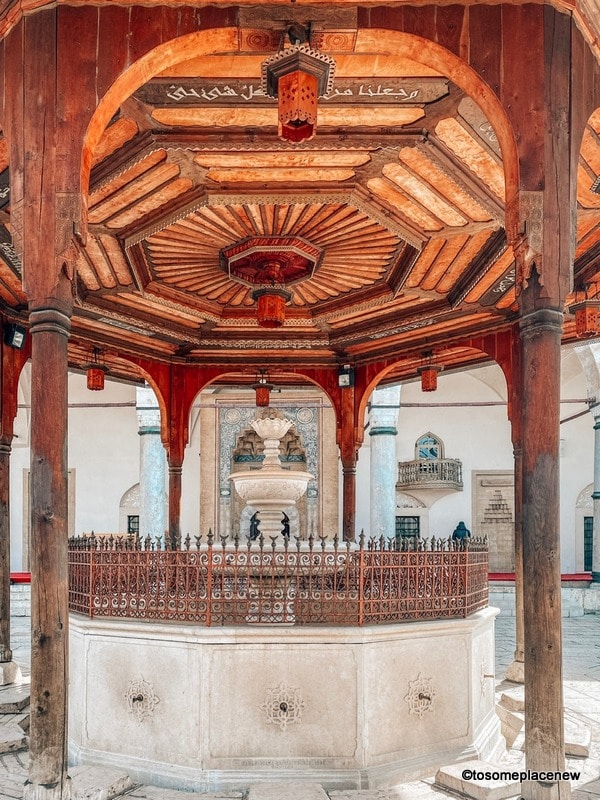
Sarajevo was on my Europe bucket list for a long time. It is a unique city that embraces the best of the east and the western cultures. In the heart of old town Sarajevo lies the Gazi Husrev-beg Mosque.
It is the largest mosque in Bosnia – Herzegovina, and was built in the 16th century. Inside the mosque complex are madrasa, water fountains, bezistan, and hammam (public bathing).
The architectural design of the Gazi Husrev-beg Mosque reminds us of the grandeur of the Ottoman Empire, and its influences on the society. This complex has the central architectural elements such as mihrab, minbar and kursi, which opens to a huge central space. And the iconic minaret can be found on the exterior.
During the siege of Sarajevo in 1990’s it was destroyed and later restored. Today when you wander the lanes of the old town you can hear the call of prayer from the mosque.
Sarajevo is known as a melting pot of cultures, and the mosque is open to non-Muslims, as long as appropriate attire is followed (like covering feet, arms. Covering of head is not necessary).
Because it is located inside the old town in Sarajevo, you will find tons of places to eat from cafes to fine dining restaurants. Popular food items to try here include Cevapi, potato pies, and Bosnian coffee.
Also read: 30 UNESCO sites in Europe for the Cultural Traveler.
The Ibrahim al Ibrahim Mosque in Gibraltar, British Overseas Territory in the South of Spain
By Paulina from Paulina on the road. Follow her on Instagram here.
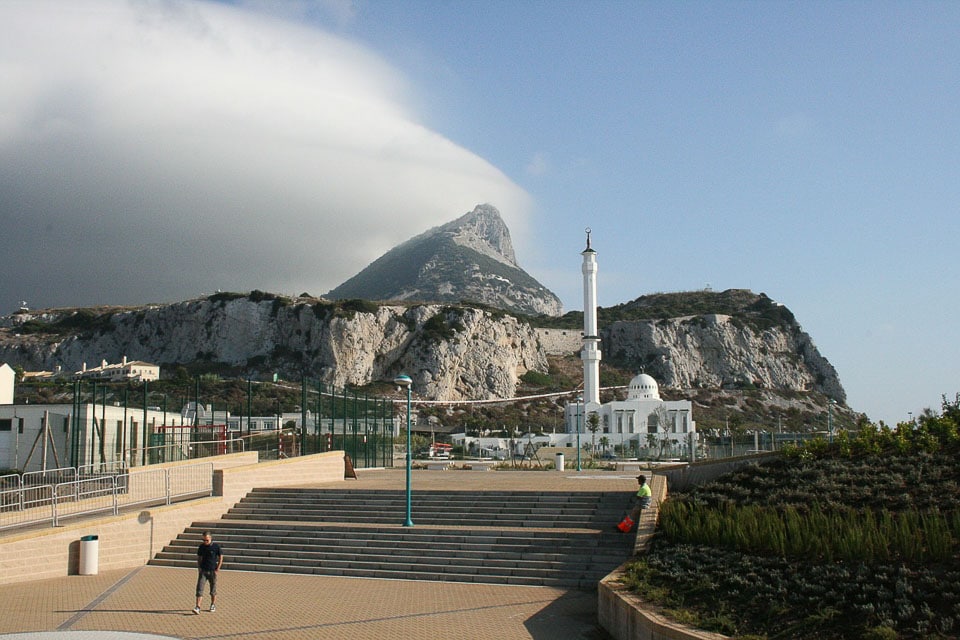
Are you looking for a unique historic mosque to visit in Southern Spain but you don’t want to visit the most famous ones such as Cordoba? Well, then I got a real gem for you: the Ibrahim al Ibrahim Mosque in Gibraltar, Southern Spain.
When thinking of Gibraltar, this small peninsula belonging to the United Kingdom but with Spanish temperatures and on the Spanish peninsula, you might first think of the apes or the legendary Gibraltar rock. However, there are plenty of other things to do in Gibraltar and visiting the Ibrahim al Ibrahim Mosque is one of them!
Located at the strategic straight and with views to Morocco, Gibraltar was vastly influenced by the Moors, who at one time held control of the Rock, and their contributions to the city cannot be undermined. Nowadays the religious site is the most southerly mosque in Europe and one of the largest Mosques in a non-Muslim country.
Admission is free and the mosque is open from 11:00 – 15:00. Please dress conservatively when visiting.
Also read: 9 traditional dresses from Europe that are sparsely used today.
The Great Mosque of St Petersberg, Russia
By Alya & Campbell from Stingy Nomads. Follow them on Youtube.
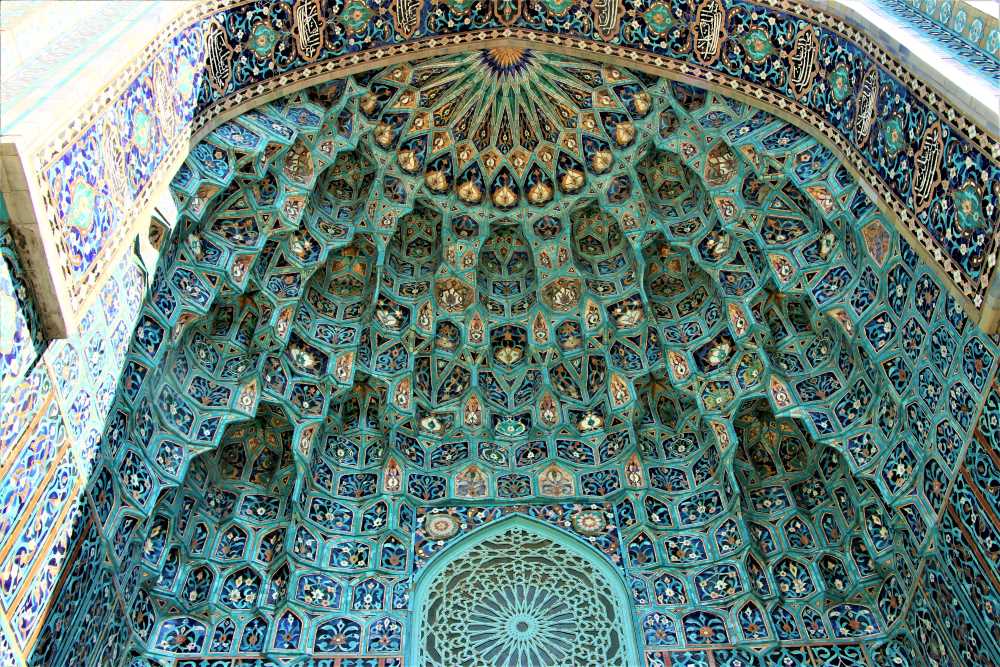
St.Petersburg is the most European city in Russia with Baroque palaces and Neoclassicism mansions dominating the architecture style. The Mosque with its huge 38-meter high blue cupola and two 50-meter high minarets stand out from the city landscape.
The Mosque is one of the most unusual places to visit in the city. The construction of the Mosque started in 1910 and finished three years later in 1913, it took 7 more years to complete the interior. It was the first mosque in St.Petersburg. The Muslim community that reached 10 000 people by the end of the 19th century waited for 20 years to get permission for building a mosque.
By the time of the construction, it was the largest mosque in Europe outside Turkey. Nowadays, it is still one of the 11 largest mosques in Europe, it can accommodate up to 5000 people at once.
Worshipers are separated according to their gender; men worship on the ground floor while women on the first floor. Non-muslims can visit the Mosque with a tour during which they can learn about the Muslim culture and traditions and admire the fascinating interior of the mosque.
It’s allowed to take photos of the interiors but not of the worshipers. There is a certain dress-code for all visitors to the Mosque. Women have to cover their heads and shoulders. All visitors have to take off their shoes at the entrance. Both men and women should wear clothes that cover their bodies, no shorts, mini-skirts or vests.
The area around the Mosque historically is a Muslim neighborhood. There are many small eateries and cafes offering traditional halal food.
Also read: 2 weeks itinerary for Malaysia, an inclusive destination in Asia!
Suleymaniye Mosque, Istanbul
Contributed by Vaibhav Mehta from The Wandering Vegetable. Follow him on Instagram. Vaibhav is a travel-blogger who inspires people to explore the world in an offbeat and adventurous way through his travel tips and itineraries.
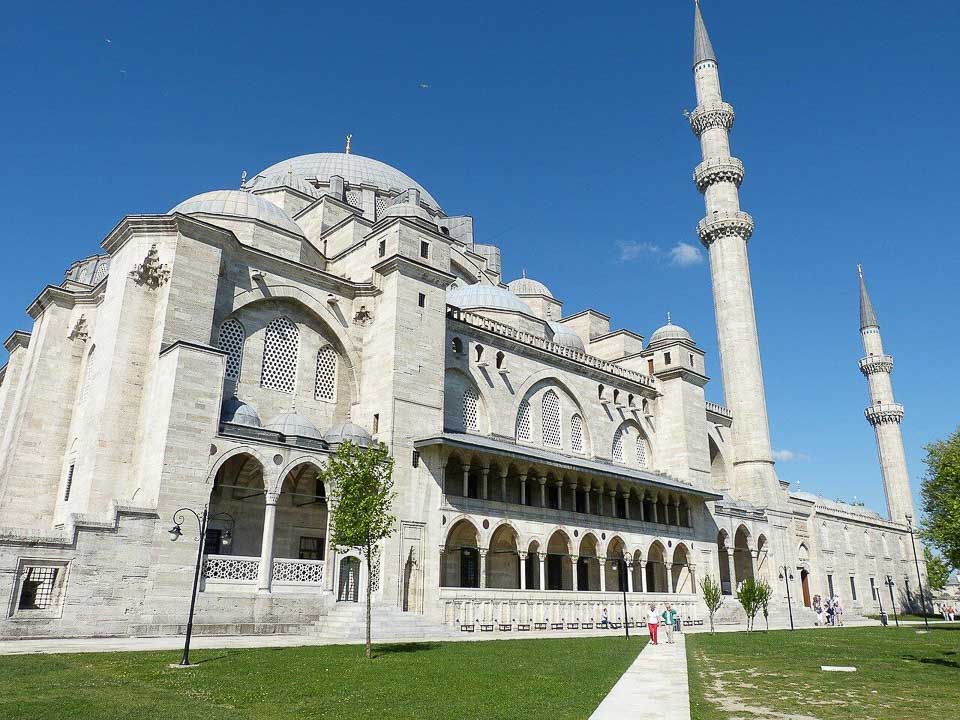
The Suleymaniye mosque is one of the most popular places to visit in Istanbul and also the second-largest mosque in the city. It’s located in the Fatih district of Istanbul and is far away from the noise and crowds of the Sultanahmet district, ensuring that you enjoy a serene atmosphere inside the mosque.
The mosque was commissioned by the Ottoman ruler Sultan Suleiman I. Construction of the mosque began in 1550 and the mosque was built by 1557. Mimar Sinan, a famous architect and civil engineer, designed the Suleymaniye mosque. The mosque was modelled on the “Dome of the Rock” in the old city of Jerusalem and asserts the historical importance of Sultan Suleiman I.
At the entrance, you are greeted by a lovely fountain in the forecourt. The courtyard is grand with columns made from marble and granite. The facade, Hagia-Sophia inspired dome, and minarets at the four corners of the courtyard are impressive and reflect the grandeur of the Ottoman era.
Inside the mosque, you’ll find stained glass windows and gorgeous Iznik tiles with floral patterns. The main dome contains several semi-domes supported by huge monoliths. The mosque courtyard has gardens from where you can enjoy enchanting views of the Bosphorus.
Irrespective of the faith, anybody (believer/atheist) can enter the mosque as long as they’re respectful of the rules of the mosque. Women are allowed to enter but have to cover their heads, knees, and shoulders. Men can’t wear shorts and women can’t wear short skirts. Removing your shoes at the entrance is mandatory for everybody.
If you’re craving a bite, there are several places to eat near the mosque like Mihrisah Cafe, Cafe 90’Lar, Erzincanli Ali Baba, and Lale Cay Bahcesi.
The Bibi Heybad Mosque in Baku, Azerbaijan
Ellis is a cultural anthropologist from the Netherlands who has travelled for more than 20 years to over 50 countries along the ancient Silk Road with a special love for India and Nepal. This geeky and introverted travel blogger is a lover of good food, mountains, nature, wildlife and everything that lightens up the night sky. Follow her on Instagram.

The Bibi Heybad mosque in Baku Azerbaijan is in a brand new building that was opened in a large ceremony as recently as 2008. Yet, it is a very important historical mosque with a long and interesting past.
The first islamic religious building was constructed in the 13th century over the tomb of Ukeyma Khanum. Shia muslims believe she was the daughter of the seventh imam and therefore a descendant from prophet muhammed.
Locally it was known as the mosque of Fatima and it attracted pilgrims from different faiths. Especially women that wanted to get children believed that praying at this mosque would grant their wishes to become pregnant.
Despite, or maybe because, this was such an important place of worship, the mosque was destroyed by Stalin in 1932 during his anti religious campaigns. Many legends surround this event.

One can destroy a building, but not beliefs. For the people in Baku the site of the Bibi Heybat mosque remained a holy place. Stories abound that those who helped in destroying the mosque died of strange accidents.
As soon as the Soviet Union fell, plans were made to rebuild the Bibi Heybat mosque to its former glory. The inside is beautiful with mirror works and a deep green color, the color of the Islam. Visitors are welcome as long as they dress modestly.
Also read: 50+ truly offbeat experiences in Goa!
Küçük Pasha Hasan Mosque, Chania, Island of Crete, Greece
Written by Gabi Ancarola from The Tiny Book, a travel blog about the island of Crete.
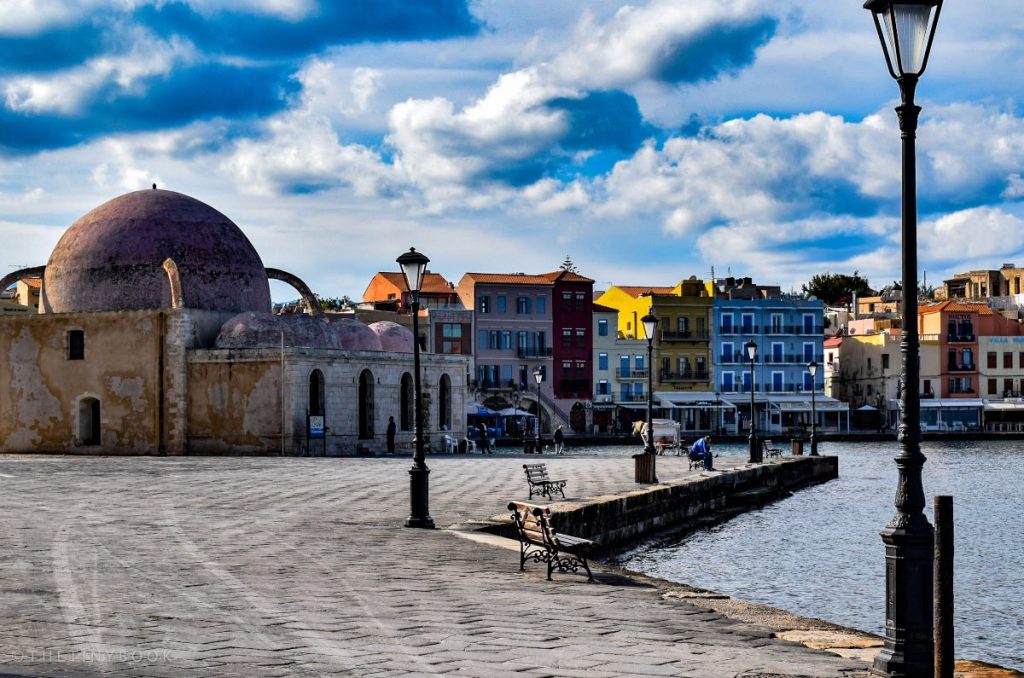
Located on the Venetian port of Chania, the small but pretty Küçük Pasha Hasan Mosque is one of the most remarkable landmarks in town.
The pink-domed building who now functions as an exhibition gallery, is a former mosque know also as Yaly Tzamisi (which translates as the mosque by the sea), and Mosque of the Janissaries, the Turkish elite army that used to pray here during the years of the Ottoman rule in Crete (1645-1898).
The Janissaries were fierce Turkish soldiers of non-Muslims origin, taken as prisoners of war. Normally between six and fourteen, they were taken from their Christian homes and sent to live with Turkish families to learn the language and customs of Islam. With time, they became the most important army in charge of maintaining the order on the island.
In 1626, when Chania was declared a Province of the Ottoman Empire, the turks erected the mosque on top of the foundations of a former Venetian church. As a matter of fact, its facade combines magnificent Venetian arches and white limestone walls, with typical Muslim features.
On the South corner of the building, inscriptions in Arabic are carved on the stone. There is also remains of a wall fountain with taps (known as çesme in Turkish), as well as the base where the minaret used to stand. Unfortunately, the tower was lost at the beginning of the twentieth century.
This is the last standing mosque in the city of Chania, although the Turkish heritage is still visible in the local architecture. Another example is the unique church of Agios Nikolaos which features the tallest minaret in the city’s skyline inside its own courtyards and next to the bell tower! Other cities in Crete, such as the Venetian Old Town of Rethymnon also have mosques worth paying a visit.
The Mosque of the Janissaries is currently open to the public and there’s no dress code to respect since it’s now a secular building. All year round, arts and crafts exhibitions take place inside the mosque and this represents a great opportunity to admire the magnificent ceilings, the bronze chandeliers, and the mihrab which has been restored after the city was heavily bombed by the Nazis during the Battle of Crete, in 1941.
The Mezquita in Córdoba, Spain
Izzy & Phil are The Gap Decaders, who sold up and quit their careers to travel Europe full time in a motorhome. You can also follow their adventures on Facebook.
Córdoba is an atmospheric southern Spanish city, rich in Moorish history and architecture. The city was occupied by the Moors for over 780 years before the reconquista in 1492, when Spanish forces finally took back their country after centuries of battle.
In Córdoba stands the Mezquita (mosque-cathedral), unique and like nothing else in the world. The Moors built a mosque in Córdoba over 1000 years ago and what stands there today is the result of numerous additions to the mosque by generations of Moorish leaders, before being consecrated as a cathedral in 1248.
Step inside the Mezquita for the first time and experience a truly speechless moment as you take in the vast expanses of marble floors and distinctive red and cream pillars and arches that stretch as far as the eye can see. Delve further in and you will find intricate Moorish tile-work and wooden carvings in the oldest parts of the building, whilst in the centre stands an enormous main chapel and soaring transept, heavily ornate and rich in detail, designed to let all-comers see the might of Spain and Catholicism.
This extraordinary mix of architectural styles and religions gives this building an air of modernity and inclusivity, despite its bloody history and the intentions of its original architects.
Reshma Narasing, solo traveler and creator of The Solo Globetrotter travel site adds,
The Mosque-Cathedral of Córdoba, popularly called the Great Mosque has been the centre of religion for both Islam and Christianity. Formerly one of the largest mosques in the world, it is now a cathedral. This UNESCO heritage site is one of the best attractions to visit in Europe.
The intriguing history of the monument dates back to 711 AD when the site was a Roman temple. When the Moors defeated the Romans later, two places of worship inside the same structure were created, thus beginning the long history of conquest by both the religions. The peaceful coexistence lasted only until one of the kings ordered the destruction of the church to make way for a spectacular mosque, the construction of which took more than two centuries. By the time it got completed, Cordoba mosque was the largest in the Islamic world after Mecca.
At the beginning of the 13th century, Cordoba fell into the hands of Christian rulers and got converted to a vast city cathedral. From then on, it has been a cathedral until today.
The site is massive, with over four buildings enriched with stunning architecture and history, and you will need half-a-day to explore. The stunning central hall is one of the most notable features, along with the beautiful blend of the Moorish, Baroque and Renaissance architecture.
There is a small place to pray for Muslims alongside the main cathedral for Christians. There are plenty of restaurants close to the Mosque, but some are expensive, catering to the tourists.
Koski Mehmed-Pasha Mosque in Mostar
By Kami from My Wanderlust. Follow her on Instagram here.
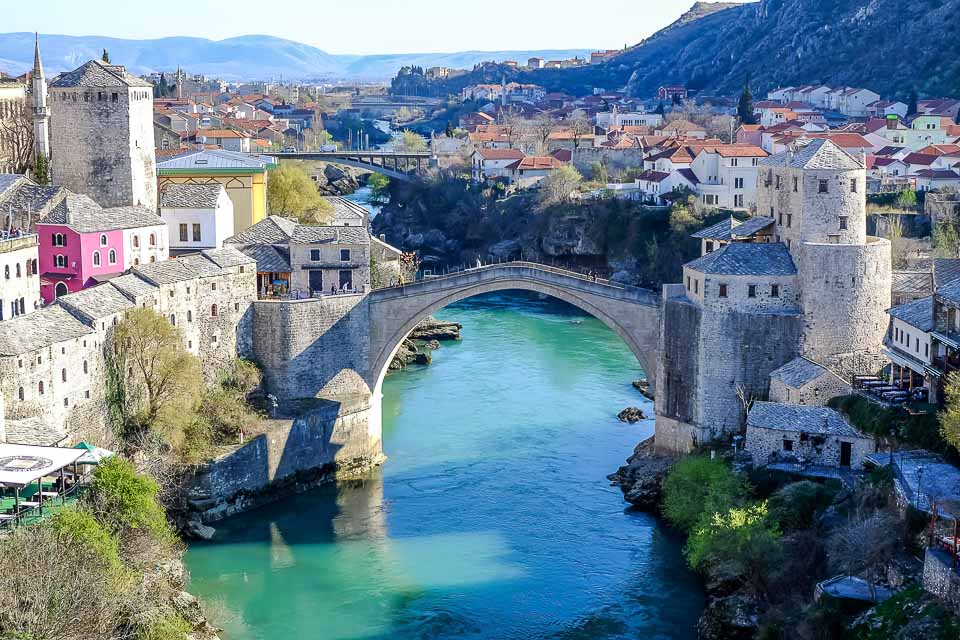
While Bosnia and Herzegovina is inhabited mainly by the Slavs, part of the country has been under Ottoman rule for centuries. That is why still today you can find numerous mosques on the territory of Bosnia and Herzegovina. Among the most impressive ones is Koski Mehmed-Pasha Mosque in Mostar.
Originally it was built at the beginning of the 17th century but, just like the big part of the city, it was badly damaged during the 1990s Balkan War. Fortunately, it was renovated shortly after the way and today you can admire its beautiful interior with stunning botanical motifs and colored-glass windows.
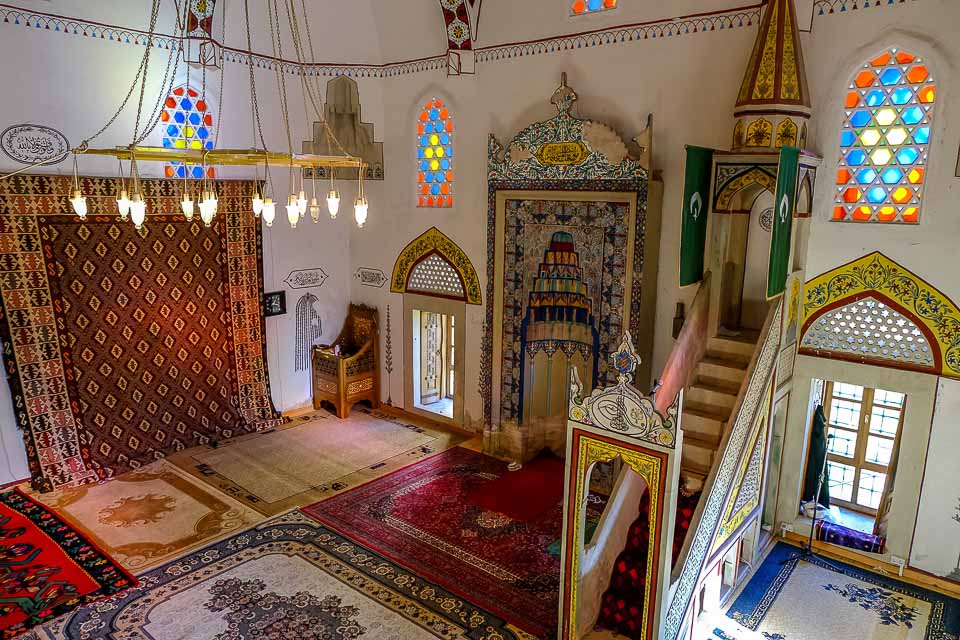
There is a small entrance fee to visit the mosque but everyone is welcomed.
Koski Mehmed-Pasha Mosque is also one of the few mosques where you can climb to the minaret. The staircase is very narrow and claustrophobic but the views are worth all the effort, the most amazing you can find in the city. Climbing to the minaret is one of the best things to do in Mostar, although it’s not for the faint of heart. Koski Mehmed-Pasha Mosque is located right in the old town of Mostar, you can all other attractions near it, as well as many restaurants and shops.
Also read: Is it safe to travel to Egypt?
Selimiye Mosque, Nicosia, Cyprus
By Helen from Helen on he Holidays. Follow her on Instagram here.
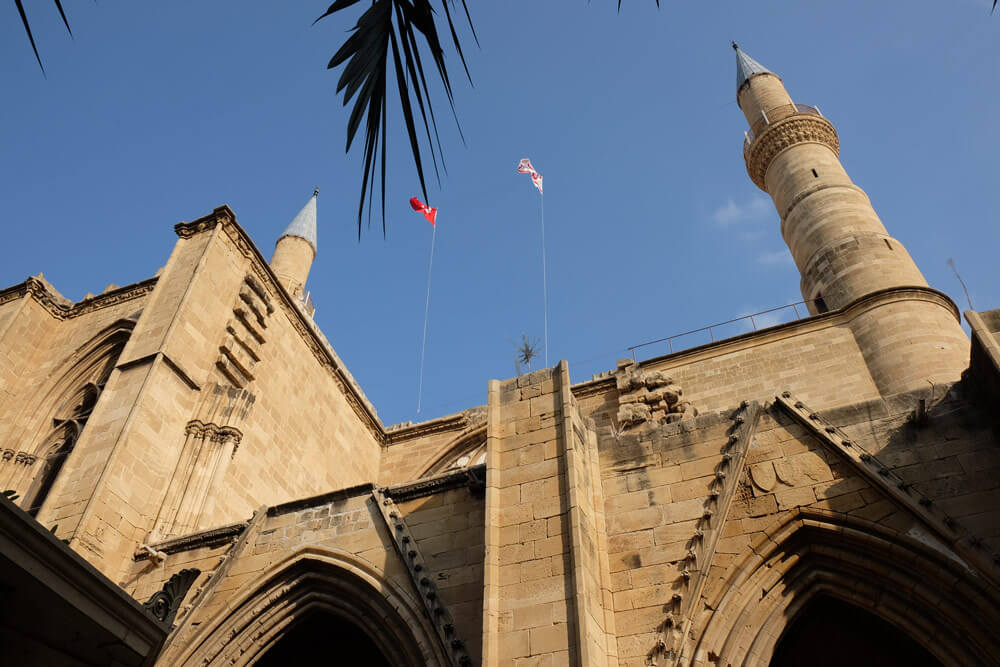
Selimiye Mosque is in Nicosia, the capital of Cyprus, and is one of the most interesting mosques you can visit anywhere in the world, because of its history, its architecture and where it is.
The Selimiye Mosque’s location is completely unique. Nicosia is the world’s only divided capital city, split between the Republic of Cyprus and Turkish-controlled Northern Cyprus and divided by a UN buffer zone called the Green Line. For decades, crossing the Green Line was forbidden but it’s recently opened up and most passport-holders can cross between the two sides. The Selimiye Mosque is in North Nicosia, in Northern Cyprus and is one of a number of fascinating sights in this part of the city.
The standout feature of the Selimiye Mosque is that it looks like a Christian cathedral – because that’s what it was originally built as. The Gothic arches, flying buttresses and internal columns are far more reminiscent of the cathedrals and churches of western and central Europe than they are of a Turkish mosque. It was originally called the Cathedral of Saint Sophia and was started in 1206 but wasn’t consecrated until 1326. When the Ottomans besieged Nicosia in 1570 the cathedral was converted into a mosque.
Selimiye Mosque is still an active place of worship, but respectful visitors of other or no faiths are able to visit. Head coverings are available at the entrance for women.
Grand Mosque of Constanța, Romania
By Arabela from The Spicy Travel Girl who is a 19-year-old full-time student and solo travel blogger showing you how to travel the world on a low budget and tight schedule. Follow her Instagram.
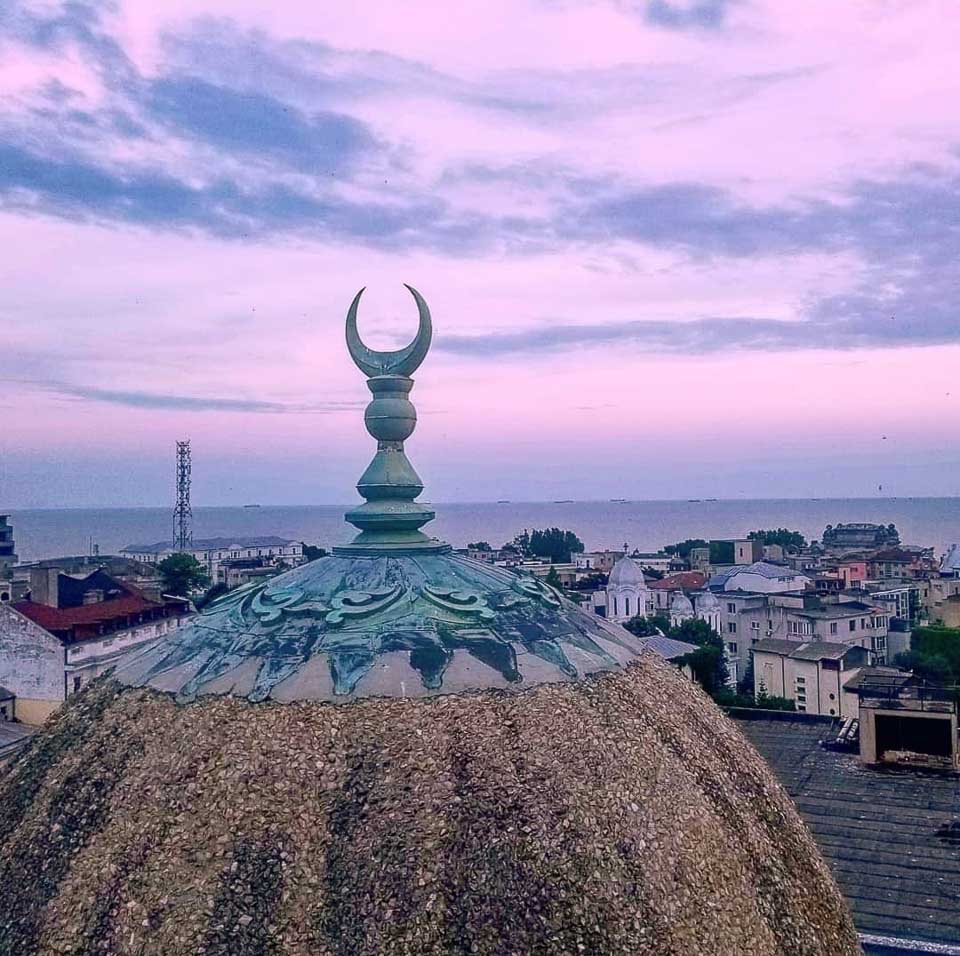
Mosques come to few people’s minds when they hear about Romania. Yet, the Muslim community’s contributions in this primarily Orthodox-Christian country must not be underestimated. One example is the Grand Mosque of Constanța, also known as the Carol I Mosque.
Constructed in 1910, this majestic mosque is a must-visit for anyone traveling along the Romanian Black Sea coast. It houses not only a variety of old treasures but also offers a stunning view of the beautiful coastal city from its minaret. Entry to the house of worship is allowed for people of all faiths, and all parts of the mosque can be visited by women. Furthermore, like many mosques in the region, dress codes are not strictly enforced and visitors dressed in shorts and tank tops can frequently be seen. The only word of caution I would give to visitors is that the staircase up the minaret is very narrow and steep. I do not recommend climbing up if you have problems walking, get easily out of breath, and are scared of heights or narrow spaces.
For the most beautiful experience, I recommend visiting the mosque on a summer evening and enjoying a spectacular sunset view from the minaret. However, the place is stunning at all times of the day and definitely worth a visit.
Also read: 15 Historic Towns of Europe for the Old Souls!
The Blue Mosque in Yerevan, Armenia
We’re Carine and Derek, two Canadians in love with this world and its wonders. We want to inspire everyone to chase their dreams and leave a positive impact on Earth. Follow on Instagram.
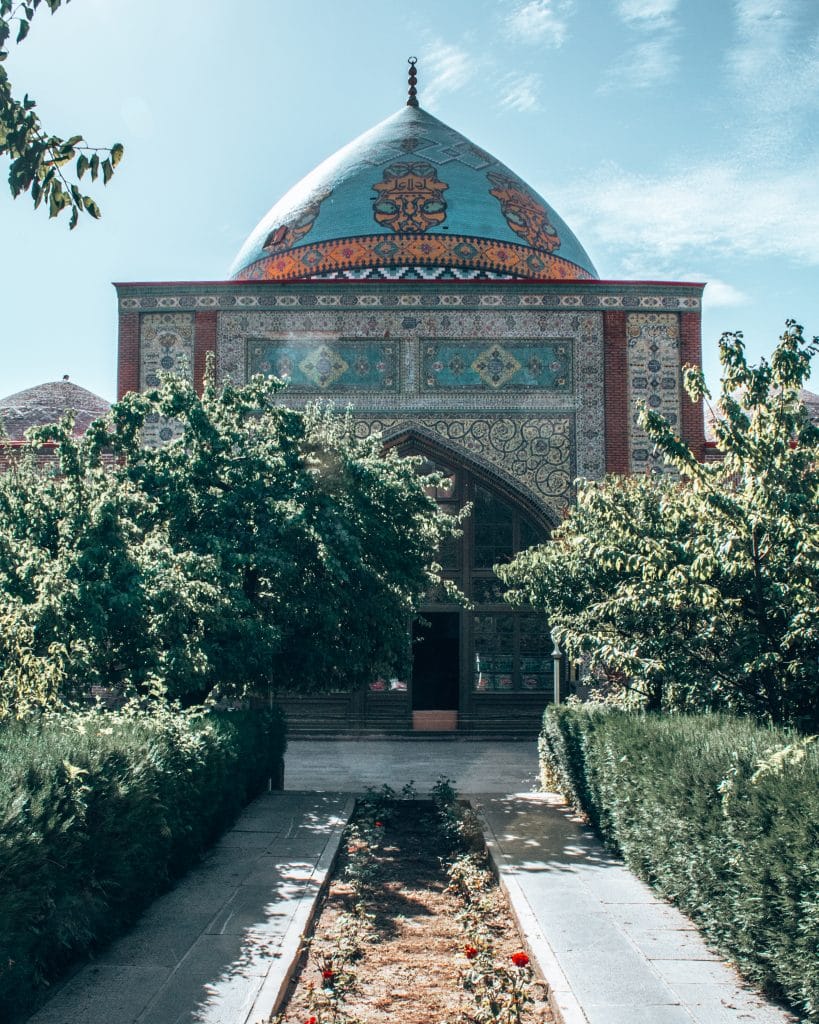
The Blue Mosque in Yerevan is one of the most special places you can visit in Armenia. It’s actually the only active mosque in the whole country. In fact, it’s not that surprising for Armenia, as Christianity holds a very important place here. Armenia was the first country to accept Christianity as a national religion. But, Armenia also has very good relations with the neighboring country of Iran, which is where the history of the Blue Mosque begins.
The Blue Mosque is an 18th-century Shia mosque. It was commissioned by Huseyn Ali Khan, the khan of Erivan. It’s one of the oldest extant structures in Yerevan. It’s also the most significant structure of the Iranian period. After Armenia’s independence in 1991, the Blue Mosque was renovated with the support from the Iranian government. It started operating again as a mosque, serving the many Iranians living in Yerevan.
The Blue Mosque is free to visit for people of all faiths. Of course, modest clothing is required for women, so make sure your shoulders and knees are covered. The Mosque is located on Mesrop Mashtots Ave, not far from Martiros Saryan St, in the heart of Yerevan’s Kentron district (the main area of Yerevan).
Because the Blue Mosque is so well located, there are a ton of great things to see and do around it. It’s within walking distance to all of the main attractions and some of the best restaurants in Yerevan (Martiros Saryan St is where you’ll find a ton of them).
If you have a few days in Yerevan, the Blue Mosque is a must-see, not only in the city but in all of Armenia. It’s a tranquil oasis in the middle of a very vibrant city. It’s also a refreshing escape from all the churches you see in the country.
Dzhumaya Mosque in Plovdiv, Bulgaria
By Anda from Travel for a while. In her words, “I love to travel and explore new places. I started a blog about a year ago, to share new places with other people who long to see the world.”
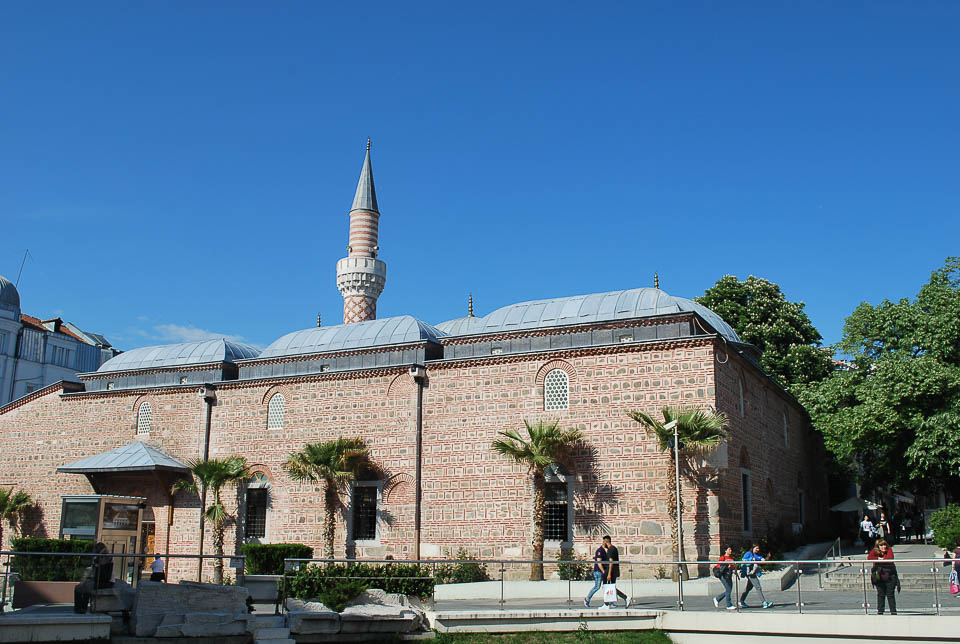
Dzhumaya Mosque is located right in the center of Plovdiv, at the heart of the pedestrian area, and close to the restaurants in Kapana area. Next to one of its corners, a very well preserved Roman Stadium was discovered and parts of it were brought to light. Seeing both these landmarks so close to one another makes you see some different periods of Plovdiv’s long history brought together.
The large rectangular mosque was built on the site of a cathedral, St. Petka Tarnovska. Soon after the Ottoman Empire conquered Plovdiv in the 14th century, Sultan Murad II demolished the cathedral and built Ulu Dzhumaya Mosque, which means the Main Friday Mosque. Another name of the mosque was Muradye.
The architecture shows the influence of Byzantine as well as traditional Bulgarian building techniques with one layer of stone alternating with two layers of bricks. Originally, Dzhumaya Mosque had two entrances, one to the east, and one on the northern side, the latter being the only one in use today. The minaret overlooks the center of Plovdiv in the northeastern corner of the mosque.
The inside of the mosque is worth a visit too, to see the beautiful paintings inside the nine domes. The mosque can be visited every day, from 6 am to 11 pm by anyone. You must leave your shoes at the entrance and women must cover their legs and arms to enter. Remember that Dzhumaya Mosque is an active Muslim prayer place and plan your visit outside regular prayer times.
Brick Lane Mosque in London, the United Kingdom
Fiona is a born and bred Londoner and founder of London-Unattached.
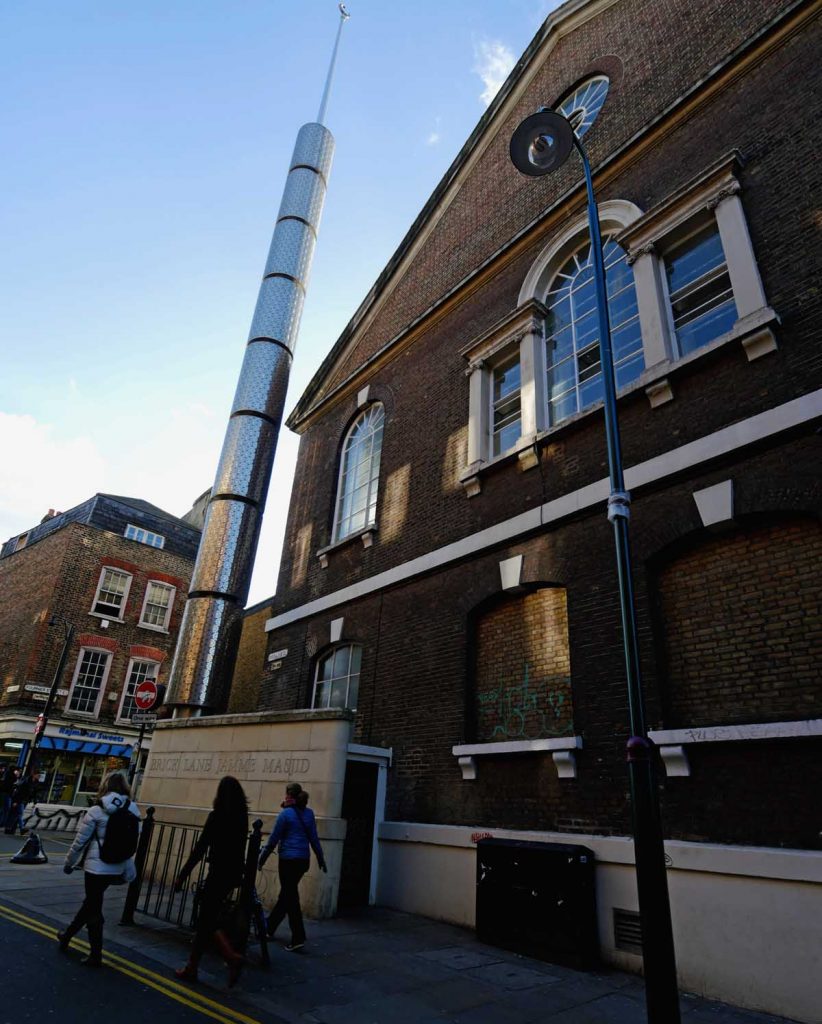
The iconic Brick Lane Mosque sits in a part of London with one of the most diverse histories and truly reflects that in its own heritage. Brick Lane in East London is now best known for a Bangladeshi community and some great Bangla and East Indian restaurants.
It has historically provided homes for immigrants to London and Brick Lane Jamme Masjid. Built in 1743-4, it was originally a French Protestant chapel serving the Huguenot community who had escaped the reformation in Catholic France and settled in Spitalfields. By the early nineteenth century the building became a Methodist chapel, in the heart of an area that was by then largely settled by Jewish immigrants.
Ultimately, the ‘missionary’ attempts failed and by the turn of the century it had become a synagogue! The most recent immigrants to move to the area came from Eastern India and Bangladesh in the second part of the 20th century – and it was then that the building was converted to a mosque. The freestanding ‘minaret’ at the front was added at the end of 2009.
The mosque can accommodate up to 3200 worshipers – there are separate spaces for men and women.
It is open to all faiths and all sermons are delivered in Bengali, English and Arabic. It is predominantly Sunni Islam and is well known for supporting the social and community needs of the area. There’s a Bangla school on Saturdays, which helps local Bangladeshi children to learn more about their ethnic heritage and become proficient in their mother tongue.
Also read: A Photo-blog depicting Bengali culture of Kolkata!
The Mezquita de Granada, Spain
Alex is a New York dreamer and mountain girl who eats way too much pizza. You can find her at Alex on the Map. Follow her on Instagram.
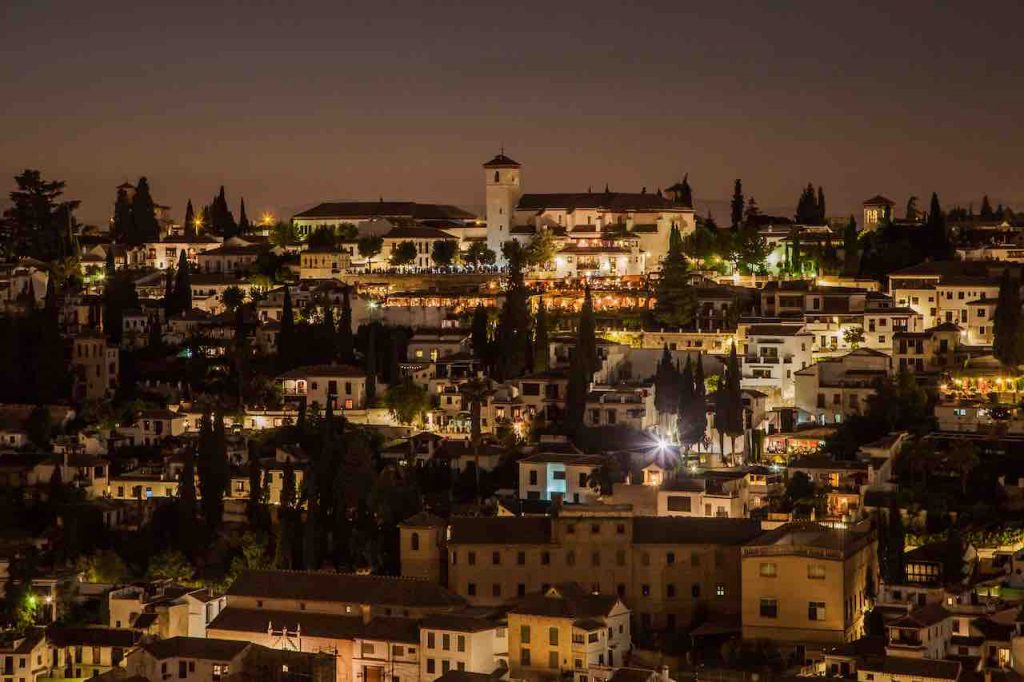
While Granada has an incredibly rich Islamic history, much of it was erased during the Spanish Inquisition when King Ferdinand and Queen Isabella drove thousands of Muslims from their new capital city. Most all buildings were torn down or converted into Christian strongholds or places of worship—most famously, the Alhambra.
However, Granada has become much more diverse in the past few years, and one of the newest additions to the city is the Mosque of Granada, or the Mezquita de Granada. Built in 2003, it’s a newer building created in the classic style and it pays tribute to the old Medieval architecture of the past.
It’s located in the heart of the city in the old Arab quarter. You can actually see it from the balcony of the Alhambra! While it is a bit of a walk up the steep hill, there are a number of local restaurants nearby. The mosque is open to everyone and there is no dress code, though you should cover your bare arms and knees out of respect. You can also book a group tour or hop in on one if you want to learn more about the history of the city and the Islamic people in it.
Banya Bashi Mosque in Sofia, Bulgaria
By Ciara from Wellness Travel Diaries (follow her on Instagram)
In the quiet yet upbeat city of Sofia, Bulgaria, is the beautiful, 15 meter wide domed Banya Bashi Mosque. This mosque was built in the 1570s during the Ottoman rule by the famous chief architect Mimar Sinan. Sinan’s alluring structural pieces also include Istanbul’s elegant Blue Mosque.
The location of the mosque is also extremely unique within this Eastern European city. It’s selective placement is part of Sofia’s religious square of tolerance. Among the square you’ll find three other religious sites from different religions, each making a corner of this sacred square. There’s the St. Nedelya Church, the Sofia Synagogue, the St. Joseph Cathedral, and lastly the Banya Bashi Mosque, each within the city center.
Today the Banya Bachi Mosque holds daily prayer services at three different times: 1:30 pm, 3:30 pm, and 8:45 pm. The Banya Bashi Mosque is the only mosque in Sofia that’s still in operation. When prayer is not in session, visitors of different backgrounds are welcome to view this grand religious site. Be sure to wear appropriate clothes with legs and arms covered. After visiting this spiritual site, you’ll find several nearby excellent Bulgarian restaurants to be explored. There’s trendy vegan restaurants with gluten-free options, and cozy eateries with outdoor seating to enjoy the peaceful ambiance Sofia brings. If you’re in Sofia during winter time, I recommend grabbing some hearty Bulgarian soup from a locally owned restaurant called Supa Bar.
Cambridge Central Mosque: The first Eco-mosque of Europe
Established in the year of 2019, the eco-mosque of Cambridge is one of the largest mosque in Europe. It is also the first sustainable mosque run with green energy in the continent. Solar panels, rain water harvesting, green mode of commute: the mosque emphasizes on reducing waste generation and lowering of carbon footprint. Quranic verses are writte on Gault brickwork, which is a traditional art of Cambridge.
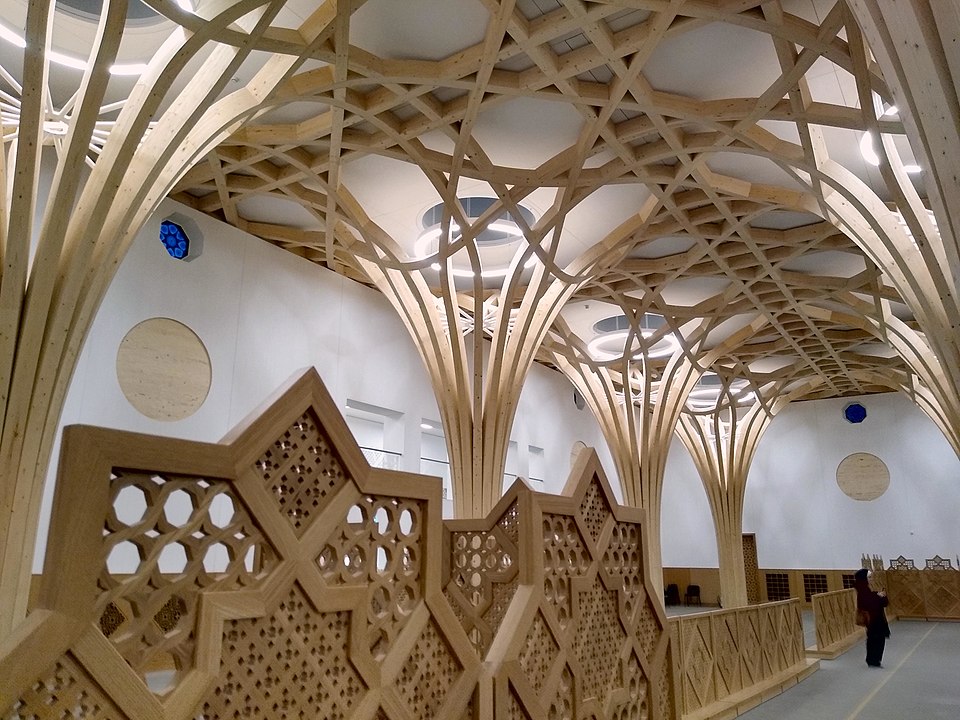
Also look out for the following mosques in Europe:
- Westermoskee in Amsterdam in the Netherlands
- Great Mosque of Paris (built in honor of the fallen Muslim soldiers during WW1. Also shelteres 1500 jews during holocaust)
- Heart of Chechnya (Important since the region has been ravaged by separatist movement since Soviet Union broke down).
- Hagia Sophia, Istanbul. Originally a Greek Orthodox Church, it was destroyed and turned into a mosque with the advent of Ottomans. During Mustafa Kemal Atatürk’s governance, the mosque was turned into a museum but things are changing with time and now Hagia Sophia is on the way to be used as a mosque again.
- The King’s Mosque, also known as the Imperial Mosque, in the old city of Pristina, Kosovo. It was built in the 1460s by Sultan Mehmet II Fatih.
Local Muslims in Europe, often the second generation, naturalized citizens, are now stressing on the fact of establishing place of worship inspired with local influence, instead of building mosque with Saudi donors, which further complicates socio-political fabric. The new mosques are coming up with innovative ideas, like building a wind mill instead of a minaret to ensure giving back to the community.
Pin it for later!
This post may contain affiliate links. Please read the disclosure post. If you have liked the article, you may support it by buying using these links without any extra cost to you.
Let’s stay connected on Facebook, Instagram, Twitter! You may also consider joining my mailing list. I send travel and photography related emails only once a month!


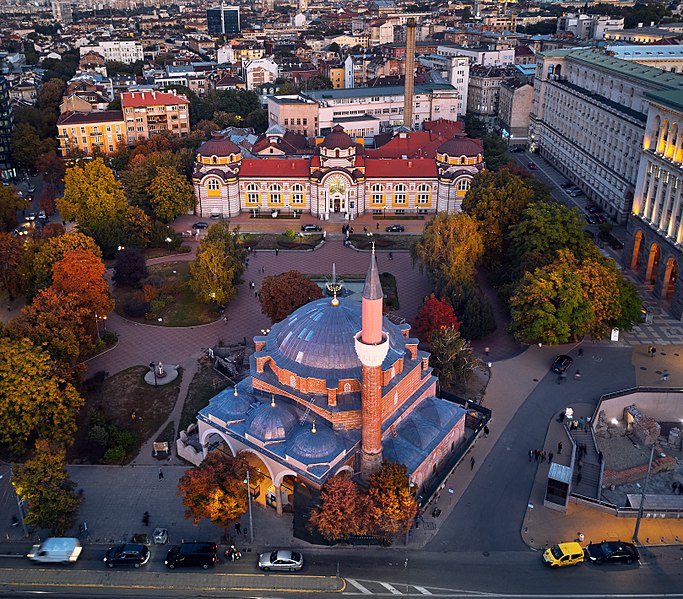
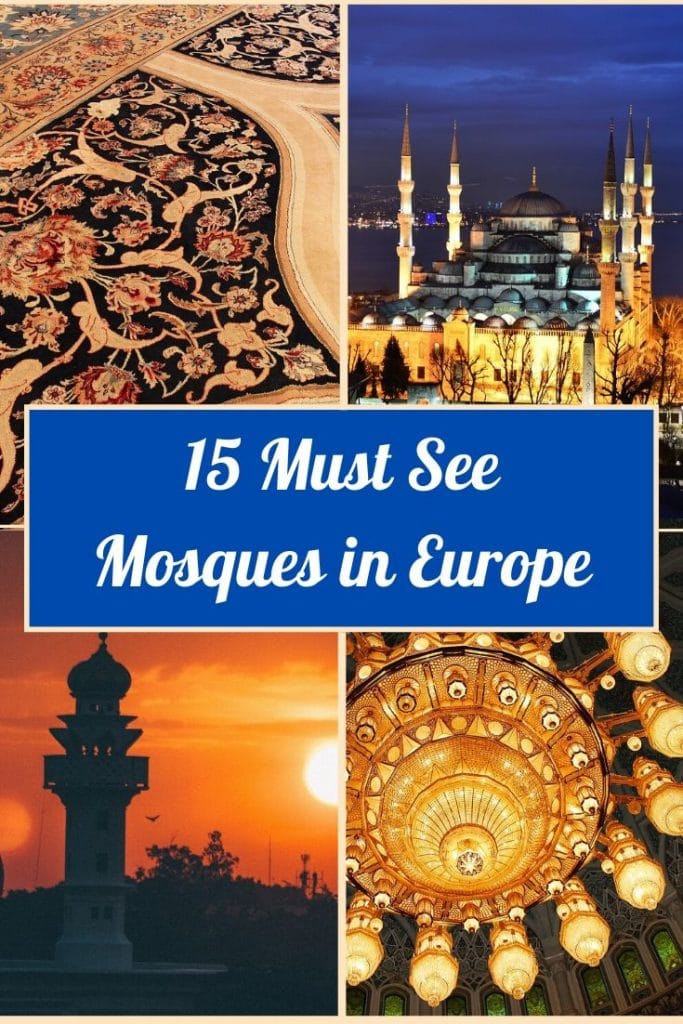
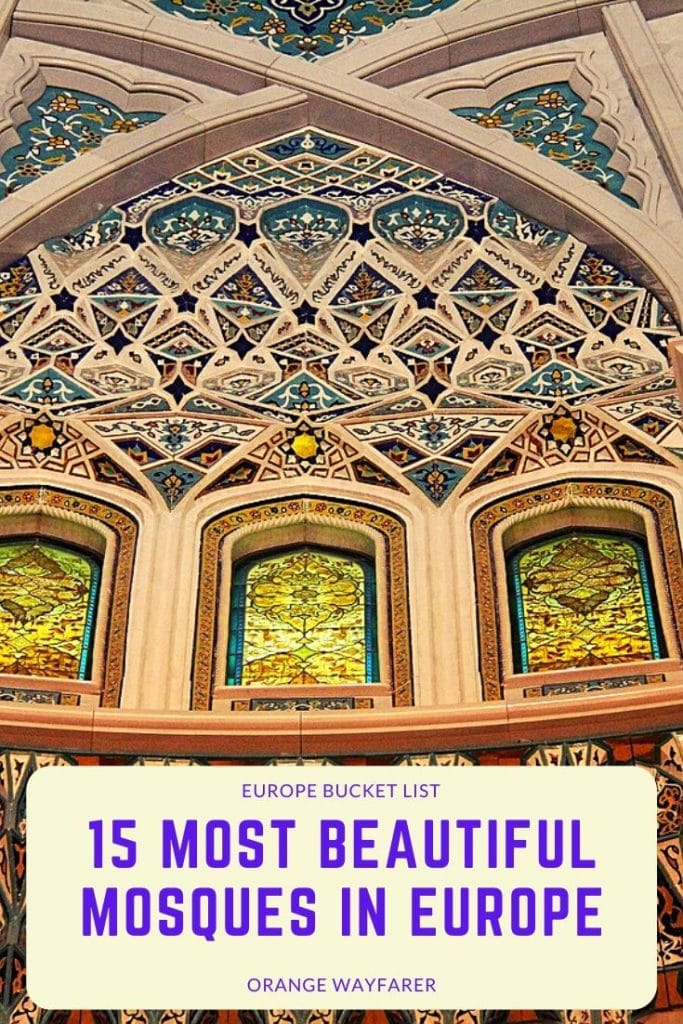
One Response